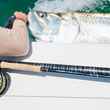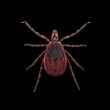This pattern came from Kirk Dietrich, a well-known angler and tier from Louisiana. The original came from Jon Cave and is known as Cave’s Wobbler.
You can tie with eyes or without. Kirk’s pattern does not use eyes or a tail. Nevertheless, this pattern should give you a good idea how to shape mylar with epoxy, not an easy task, even for experienced tiers. Kirk has a video of the process on YouTube. Watch it and learn. What’s lost in the video is the amount of manhandling and shaping involved in the tying process. To tie this fly well, you have to tie aggressively but maintain precision under the duress of drying epoxy. It takes practice, but it’s worth it.
I use this fly as a searching pattern and for tailing reds in the marsh grass of Northeast Florida. It works on trout as well.
The reason behind its success is two-fold. One, fish can’t seem to resist the flash; two, it sinks slowly, so it gives grass-dwelling reds a chance to see it while they’re feeding. Cave’s pattern tends to get hung up in the grass a bit more. The mylar spoon, because it doesn’t use lead eyes, tends to hang up in the grass less, a bonus since we’d all like to fish more and not fret about fouling our fly.
MATERIALS
Size 2 or 4 hook
Gold, silver or copper Mylar tubing (XL, approximately half an inch thick)
5-minute epoxy
30-minute epoxy
Red Flymaster thread
0.15 lead wire
HOW TO TIE
1) Start the thread a bit behind the eye. Attach the wire, make five wraps, secure, tie off.
2) Wrap the thread back, advancing a third of the way into the bend. Use a half hitch to keep the thread in place.
3) Cut a piece of mylar approximately the length of the hook. Remove the stuffing. Take the mylar and flatten it out. You do this by ironing over the length of it just as you would a long sleeve shirt. After you’re done, the mylar should look like a stick of gum.
4) Slide the mylar over the eye and along the shank. Take the thread and work it into the center of the mylar. Take two loose wraps and cinch the mylar down to the shank. The mylar will naturally want to spin, so hold it in place with your thumb and index finger while pulling the thread straight toward you. This takes a fair amount of pressure. Too much and you break the thread. Too little and your mylar body will not be secure.
5) With the mylar under control and in place, take five or six wraps down the bend. Whip finish. Tie off.
6) Congrats. You’ve got the tubing attached to the hook. That’s not easy. Mix your five-minute epoxy with a toothpick. When you’re done, use the toothpick to swab the inside of the mylar with three or four dabs. For size 2 and above, I use four dabs of epoxy. Make sure you get the epoxy as far back as you can. If you swab too much toward the eye, you will create a mess in step seven.
7) Push the mylar back with one hand, and re-attach your thread near the eye, make a couple wraps back toward the bend and work the thread into the top of the mylar. Make two soft wraps. Hold the mylar between your thumb and forefinger and pull the thread straight toward you to secure. Make two or three wraps, half hitch and tie off.
8) The shape of your spoon is almost finished. Now you have to shape it by mashing the body and edges into a cupped shape as the epoxy cures. Drying time is about an hour.
9) You can color the fly with permanent marker, or skip that step and coat the body with 30-minute epoxy. Make sure you mix thoroughly, at least 90 seconds, before applying. Let it cure on a drying wheel overnight before applying a second coat. You can tie in a weed guard before the first coat or in between coatings.






























Comments